|
COME BACK TOMORROW
When shall we live, if not now?
South Wales is ugly. Like, coyote ugly. Most of the more scenic parts of the principality are found in the relatively unspoiled centre and north, but the vast majority of the population settled in the south, where the land was a little flatter and the sea a little warmer and the living a little easier, and as a result industry and the general presence of humanity has blighted whatever natural beauty may have been found there in the distant past. Nowhere is this more starkly illustrated than in the once-thriving steel town of Port Talbot - a grimy grey bay halfway between Wales' two cities of Cardiff and Swansea, permanently shrouded in thick smoke clouds and overlooked by bleak, barren hills forever scorched to a rusty brown by years of pollution - but the desolate southern side of Cardiff gives it a run for its money.
And yet it was in the latter place that your intrepid reporter recently found himself, crawling along in snail's-pace traffic through a dystopian hellhole of bad urban planning and criminal neglect in search of excitement and life-affirming joy. Frankly, the chances looked remote.

This picture is probably some kind of metaphor for something.
It was partly my own fault. Roadsigns in Wales are so packed with incomprehensible gibberish (or "Welsh", as the small-but-vocal minority of idiots who insist on inflicting their long-dead tongue on everyone else prefer to call it) that there's no room for any useful navigation information, so I'd dim-wittedly taken the wrong exit off the motorway and was blindly trying to bludgeon my way through suburbs of Cardiff (in Welsh, "Cwhlldythd") that I should never have gone anywhere near, on route to the seaside oasis of Barry Island.
Barry Island ("Ddsythr-i-glysgllng") is a really unusual place. It's a peninsula, but it used to be an actual island until the building of docks in the late 19th century linked it to the mainland, and now the casual visitor would never know it had ever been separate (there are no tell-tale bridges or causeways to cross, for example). The small former-industrial town of Barry itself is grim and run-down, and it's not until you're practically on the promenade that the idea of it hosting Wales' premier seaside resort seems anything other than a cruel joke.
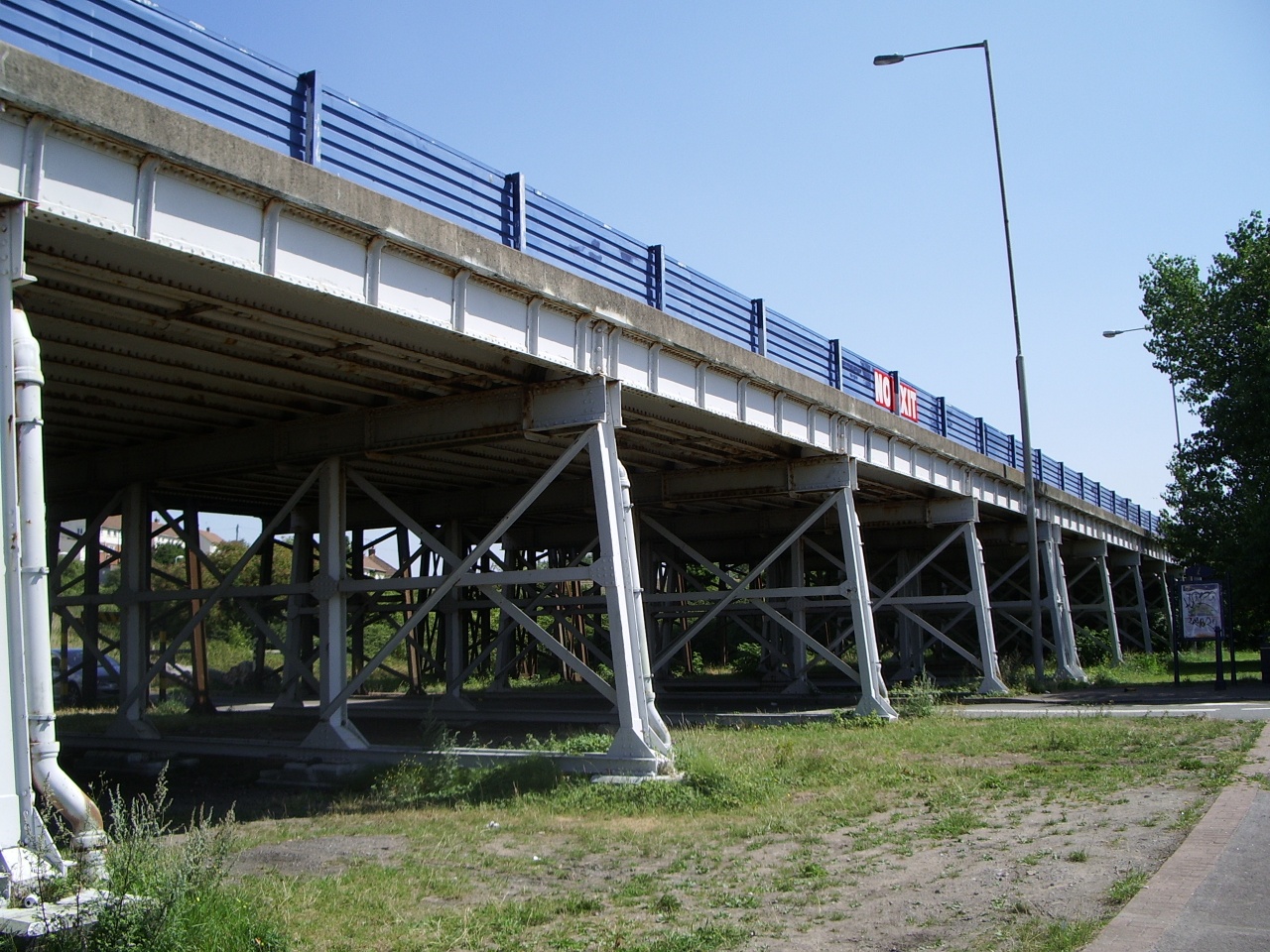
Click for a close-up of the welcoming billboard at centre right.
On finally escaping the dizzying maze of central Cardiff (clearly, since it's only four or five miles away, residents would already know where Barry was so there's no need to put it on any signposts in the city, and tourists would of course have taken the correct exit off the motorway, so you have to guess your way there by trial and frequent error), you arrive at an expanse of tarmac-covered wasteland that appears to be the town's only car park and are relieved of several pounds by way of a flat-rate fee. There are no clues as to the location of the actual seafront, but most of the exits turn out to lead there anyway (after all, where else would you be going?) and moments later you get your first glimpse of the resort itself.
Ominously, when you do, it looks like this.
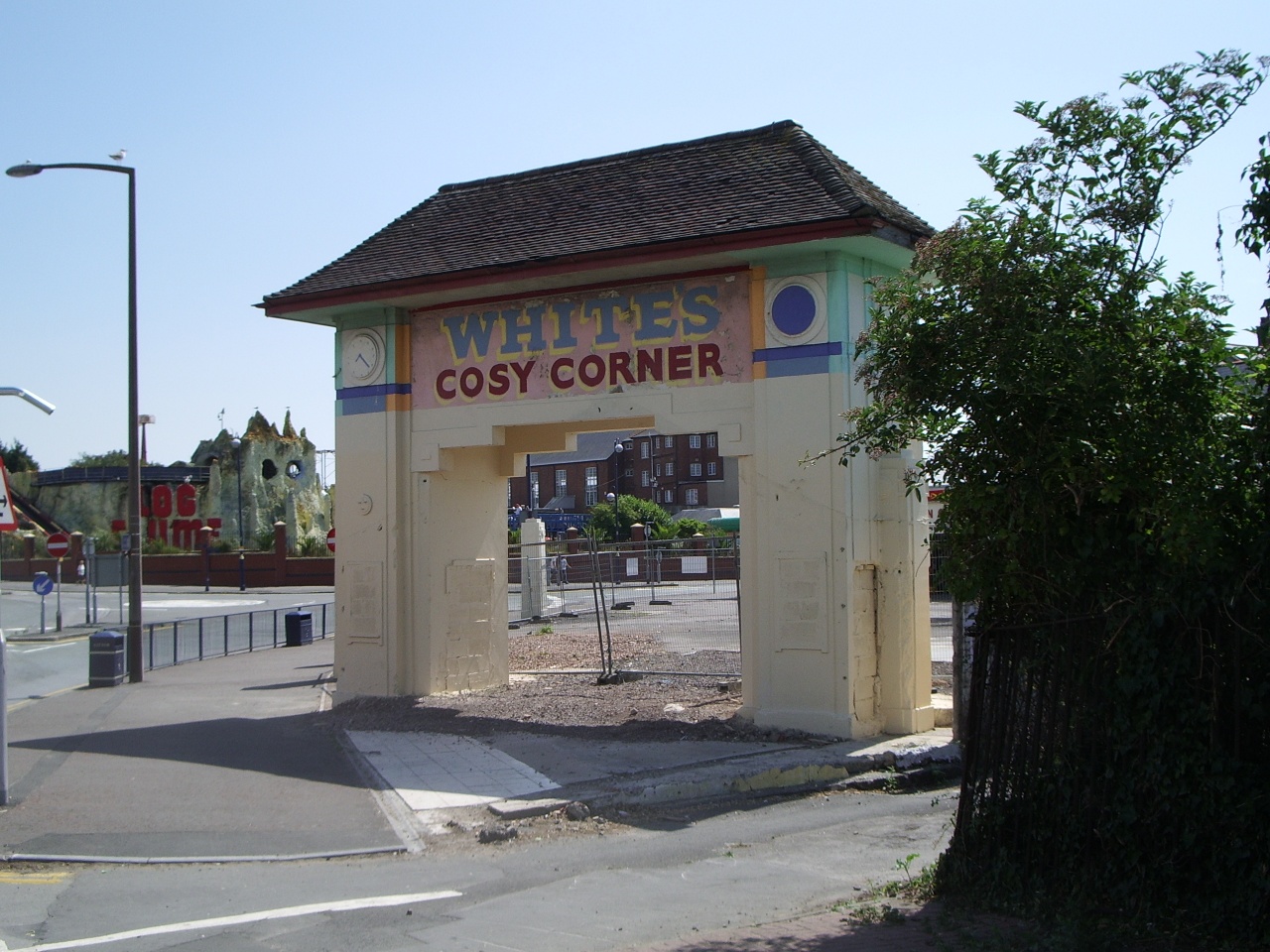
Man, how
rough must the Negro corner be?
Abandoned ruins would turn out to be something of a signature feature of the town, but if you had to pick a single word to try to sum up Barry Island, that word would probably be "closed". I visited it on a blazing-hot summer day, the sun beaming down from a clear blue sky in the middle of August, during the school holidays, and yet barely anywhere was open for business. Ice-cream kiosks, rock shops, fairground stalls and rides, arcade games and almost every other kind of attraction in the town, were all either boarded up, out of order, unmanned, chained and padlocked, or barricaded behind gates and fences and metal shutters, leaving the hordes of trippers - and there were hundreds of them on the beach alone - wandering helplessly around with nothing to do and little to spend their money on.
We'll come back to some of these scenes in a little while, but it's safe to say that throughout all of this reporter's travels to some of the UK's quirkier locations on behalf of the viewers of WoS, a nation's number-one family resort destination completely shutting up shop at the peak of a seemingly busy tourist season may be the most flat-out baffling thing I've ever seen. But there was plenty more weirdness still to come.

Shame this café was closed, though. I could have done with a bucket of chips for 0p.
Among the few things actually open in Barry were the amusement arcades. As is the way with even seaside arcades nowadays, there were precious few videogames to be found in any of them (though in fairness there was a single "Ultracade" cabinet in one, with about 30 classic games in it including Mr Do! and - rather oddly - the Japanese version of Super Space Invaders, identifiable by its "Majestic Twelve" title), with most of the space being given over as usual to a variety of fruit machines, crane grabbers and coin-pushers.
The grabbing machines were of a particularly mendacious nature, with lots of high-quality toys on display (including the classy licenced Nintendo gear seen below, and a set of large Family Guy plushies) but with the metal claws set to brush them so limply that they wouldn't have disturbed a swarm of houseflies sleeping on the nylon fur, far less actually lifted the prize into the air and across to the win chute. But much stranger were the coin-pushers. Or to be more accurate, the things you could win from the coin-pushers.

The Simpsons toys are actually in the adjacent machine.
Since winning a big pile of grubby 2p pieces no longer holds quite the thrill it once did for today's hedonistic holidaymakers, it's now standard practice for coin-pushers to also balance small trinkets on top of the money to make the whole business rather more exciting. Costume jewellery, keyrings and figurines are all commonplace, and model cars like the one you see in the picture below are particularly popular. But in Barry Island, almost every one of the dozens of coin-pusher machines in the numerous arcades contained a prize I've never seen anywhere else. It's just to the right of centre in the shot, and if you can't quite make it out, you can click the picture to see it in extra close-up clarity. It's a sawn-off shotgun.
In fact, to be more specific, it's a gold-plated sawn-off shotgun.
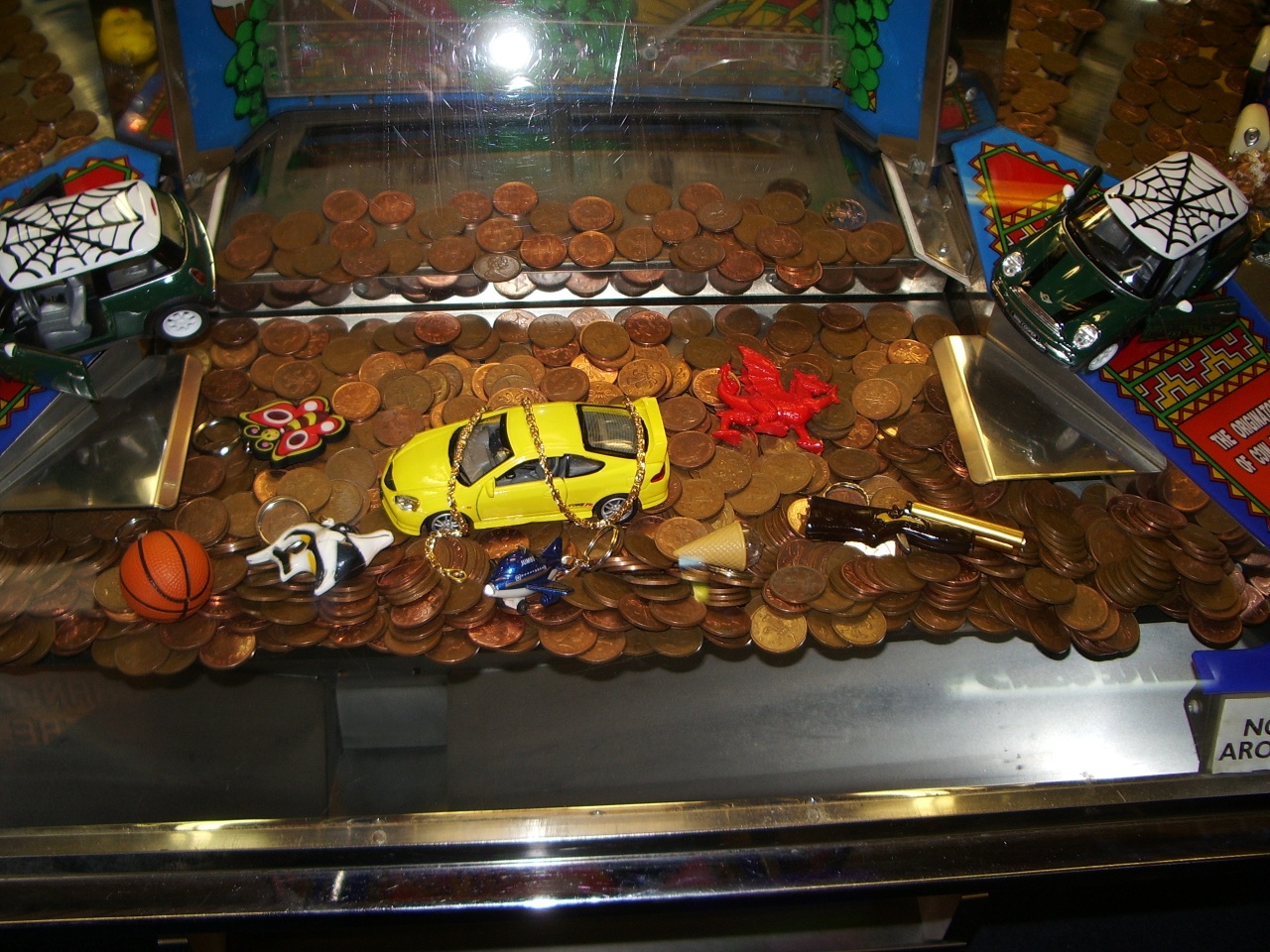
An original goldie-lookin' chain, there.
Yes, for reasons this reporter is frankly too alarmed to look into too deeply, it turns out that the top toy for 2p-toting toddlers in South Wales is a keychain replica of the lethal weapon favoured by murderous East End gangsters. Kids like guns, of course, but in South Wales they don't choose a cowboy's six-shooter, a WW2 tommy gun or a space death-ray zapper. In South Wales, they aspire to the sort of kit the Kray Twins would have gotten tooled-up with to go and turn over the local Nat West, and I don't mind telling you, viewers, that I suddenly developed a much tighter grasp on the bag with my camera and DS Lite in it.
Aside from the threatening, the contents of the town's other coin-pushers were just plain weird. Despite being in Wales there were lots of souvenirs of London, and one especially intriguing machine contained keyrings featuring all the classic kids' toys - a fire extinguisher, a Philishave razor and the decapitated head of Tweety Bird from out of Looney Tunes. Slightly unnerved, I left the arcades behind and headed for the front.

The pavements aren't quite as well-tended as the grass.
It's not until you're practically in the water that Barry Island finally blossoms, and you can begin to understand why anyone would ever come here. Step clear of the tatty, boarded-up streets of the town and suddenly the vista opens to a broad, lush expanse of well-tended grass, commanding a high view across the bay that forms the heart of the resort. Beyond the lawn is a wide tiled promenade graced by two large and pretty colonnades - one full of shops and restaurants, and the other of which is completely, curiously, empty. And backing up to those is the vast, almost-square beach stretching away hundreds of metres to the sea.
Whitmore Bay, to give it its Sunday name, is one of the secret treasures of the UK's coastline. Sheltered by headlands at both sides, it could accommodate thousands of people in tranquil comfort without being pushed for space on its pale, fine sands, and the few hundred present on this day - clustered around the "occupied" colonnade at the western end - barely make a pinprick in its generous acreage. You could hold about 30 football matches here at once, without ever worrying about anyone having to go and fetch the ball out of the ocean.

Even, as you can see, if Frank Lampard was playing.
But make no mistake - secret treasure or no, Whitmore Bay ("Ngthhyll Ryddsth") is still the British seaside, so decay and dereliction can never be far away. And sure enough, 200 yards on, between the empty colonnade and the eastern headland you find some.
It's fairly hard to figure out what the large stone-and-concrete structure adjacent to the eastern colonnade used to be. Every possible point of entry is bricked up and/or fenced off, and it wasn't until I got home and looked at the pictures that I spotted the only clue, in the shape of the letters "OYS" carved into a pillar on the left of the shot below. (Presumably there was a "B" above it, but in all conscience you can't say it's there in the pic.) The obvious conclusion would be that the structure used to be a public toilet, but nothing else about it supports the idea. For a start, it looks like it had huge windows/doors, and you don't want those in a toilet. The lower part is full of bricked-up archways, and whatever used to be in there, you wouldn't imagine whoever once occupied them would want to be situated under a public convenience. And lastly, on the middle level there's a blocked-off stairway up to the second roof, and why would you invite people to caper around on a toilet roof? Unless you were actually trying to design a viewing platform for perverts, of course. Brrr.

Maybe it was once a giftshop ("TOYS"). But you wouldn't carve that into the stone, would you?
The ruin still had one more curiosity to deliver. The entire roof of the top section was enigmatically strewn with literally thousands of rusty nails. They'd evidently been there so long that they were partly fused into the concrete, and were scattered pretty evenly across the entire area. There were none anywhere else on the structure, leading to the inescapable conclusion that the upper roof had been specifically and purposely used as some sort of surplus-nail dumping area. Which is, y'know, a bit odd.
Intriguing as it was, there was no more entertainment to be gleaned from clambering around on a crumbling old eyesore, so I made my way carefully back down the loose scree and headed off along the cliff path around the headland in search of new stimuli. But as it turned out, I'd reached the limits of Barry's amenities. Apart from some rather agreeable views of the shoreline and a close look at a building site (and a weird cloud formation that made me think of the Liberal Democrats), there was nothing more to be seen, so I turned round, strolled back along the prom and headed once more for the town centre.

Where's Waldo? Click to see if you can find him.
There was still one unexplored facility on the island for your fun-seeking correspondent to investigate, and the name promised much - Barry Island Pleasure Park. A year-round funfair boasting several large rides including a log flume and rollercoaster, as well as arcades, nightclubs, restaurants and even its own radio station, the park dominates the skyline of the town as well as occupying a large proportion of its built-up frontage.
Unfortunately, it's also the starkest possible signifier of the fact that Barry's best days seem to be far behind it. The Pleasure Park is a hideous and depressing concrete corpse, and its deathly presence embodies the over-riding spirit of the town (that is to say, "closed") more comprehensively than anything else in it. Join us now on a brief picture tour:

To be honest, this shot probably gives you a pretty good idea on its own.

"Barry Island FM - the beating heart of Barry!"

Man! Those sure are some jazzy bins!
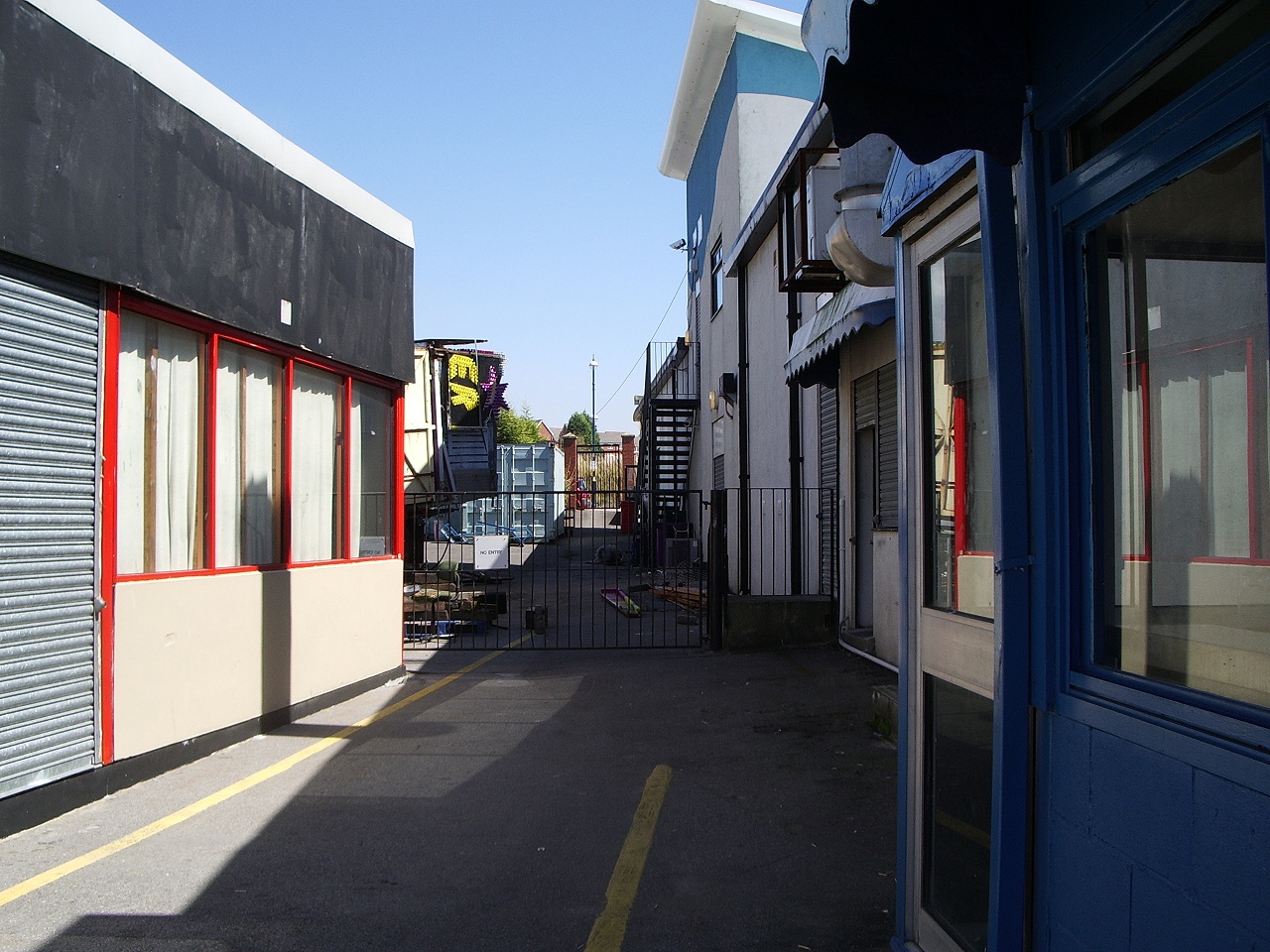
Getting that holiday feeling yet?

It took seven pics until I captured the Twister with its logo showing.
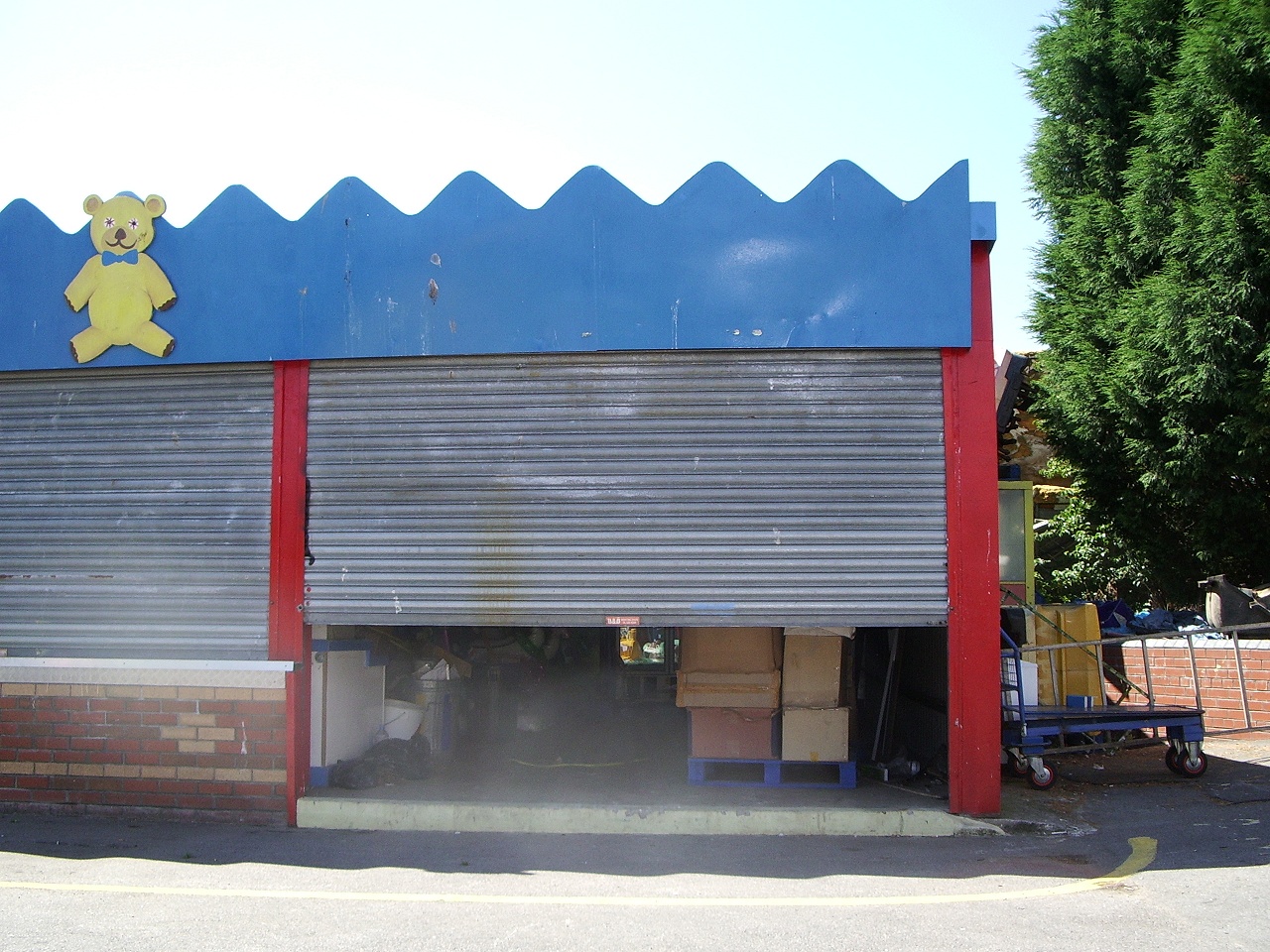
Shopping for cardboard boxes, Indiana Jones-style.

So good, they named it twice.

"AIEEE! MY EYES!"
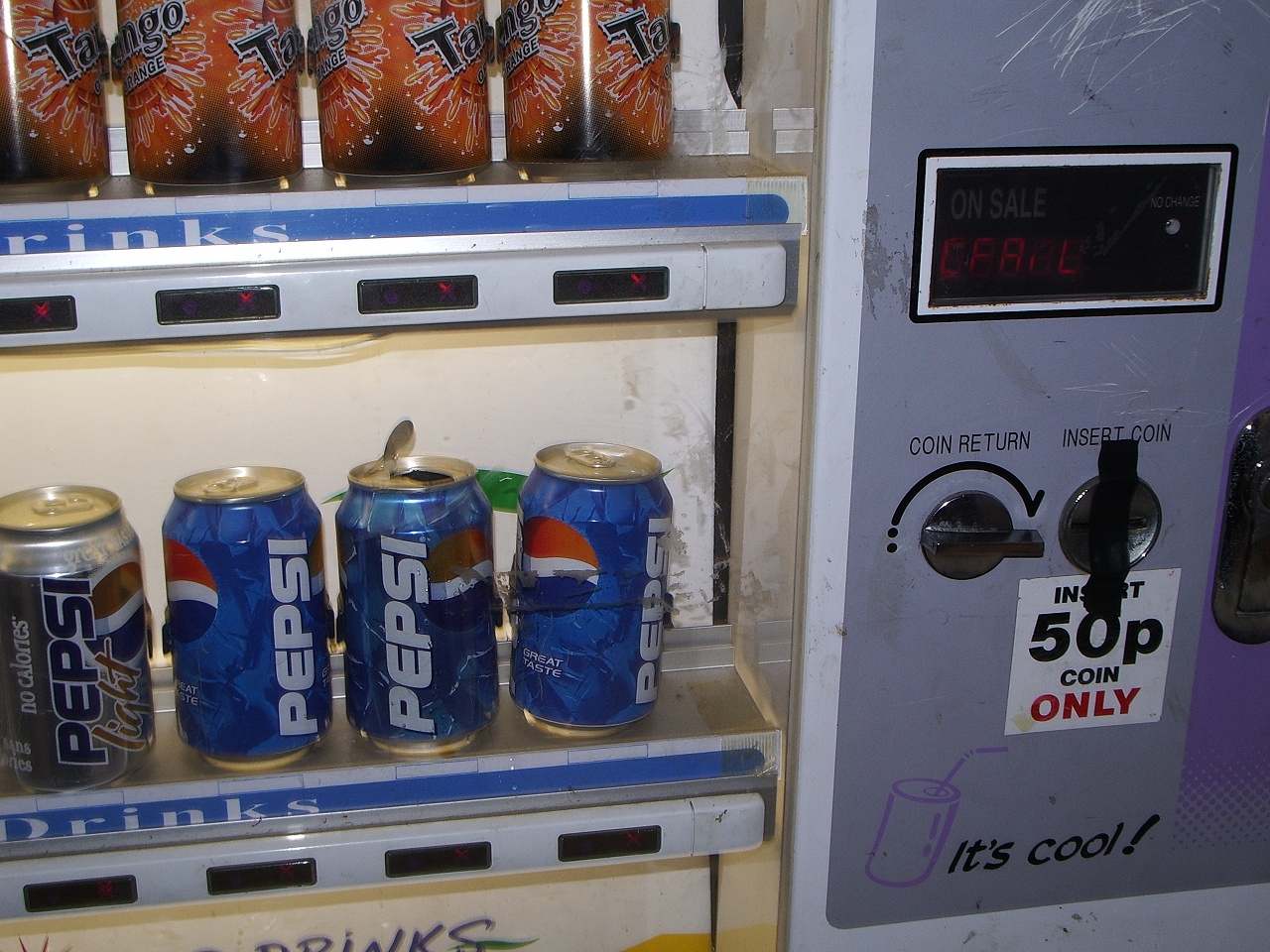
Only 50p for a used can of Pepsi? Bargain!
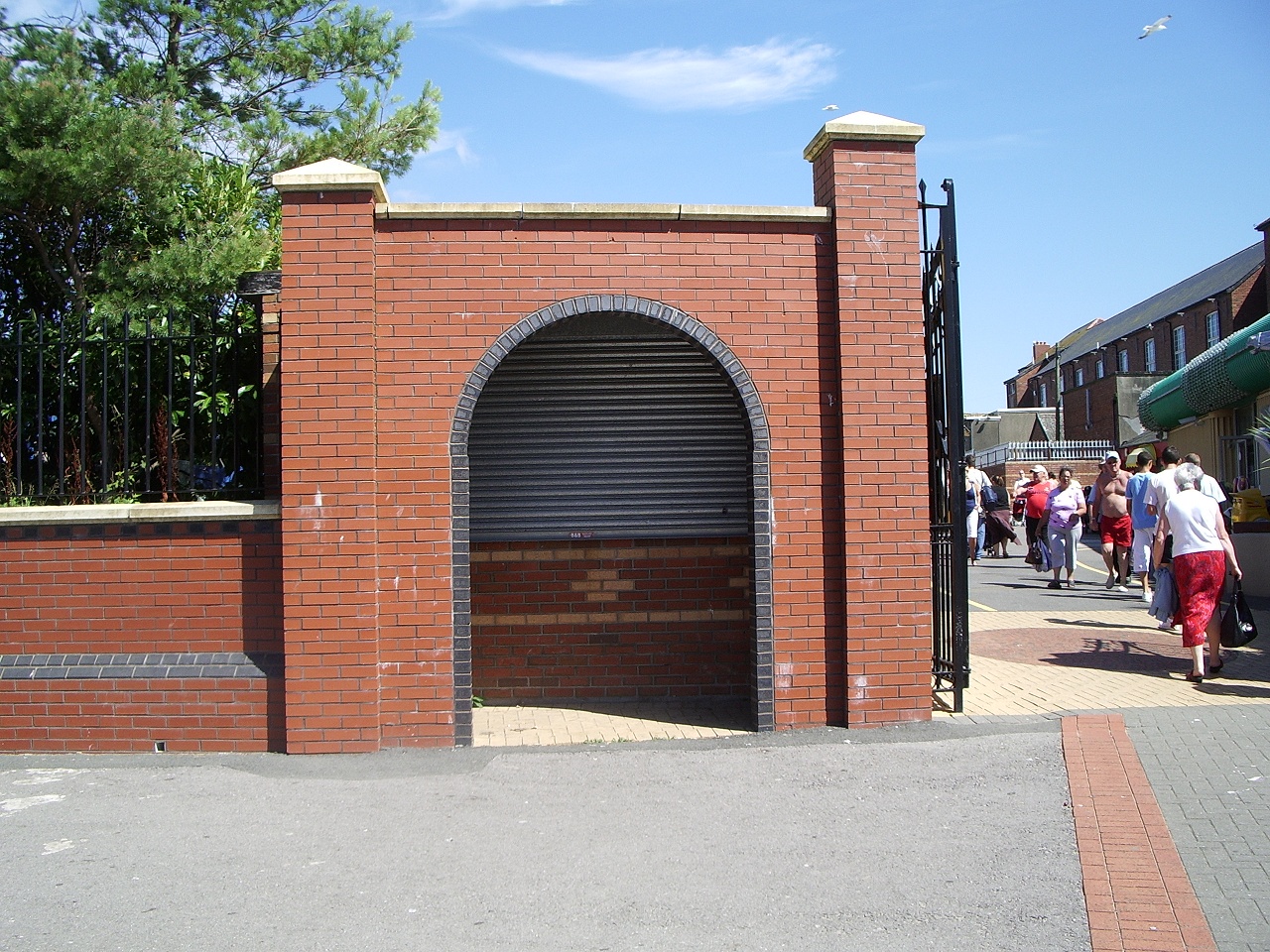
I'm sure this is just a brick wall, with a metal shutter on it for extra atmosphere.
Remember, chums - all of these photographs were taken on a sweltering hot day during a long heatwave in the middle of August ("Rthgllyn") with the beaches full of happy holidaymakers. You could easily be forgiven for wondering what the hell - if this wasn't a suitable opportunity to do a nice bit of business - everyone was waiting for.
I didn't linger long in the Pleasure Park ("Yfydd Dyfydd"), nor at the market stalls clustered around its entrance like the shacks of a shanty town, flogging cheap, ugly polyester clothes to the poor or the simply terminally tasteless. The gleaming silver centurions who guard the park's gates looked down on the scene with sad expressions, perhaps reflecting wistfully on happier times, and I knew how they felt. And when you start to find yourself empathising with the feelings of a couple of painted plaster statues, it's probably time to leave.
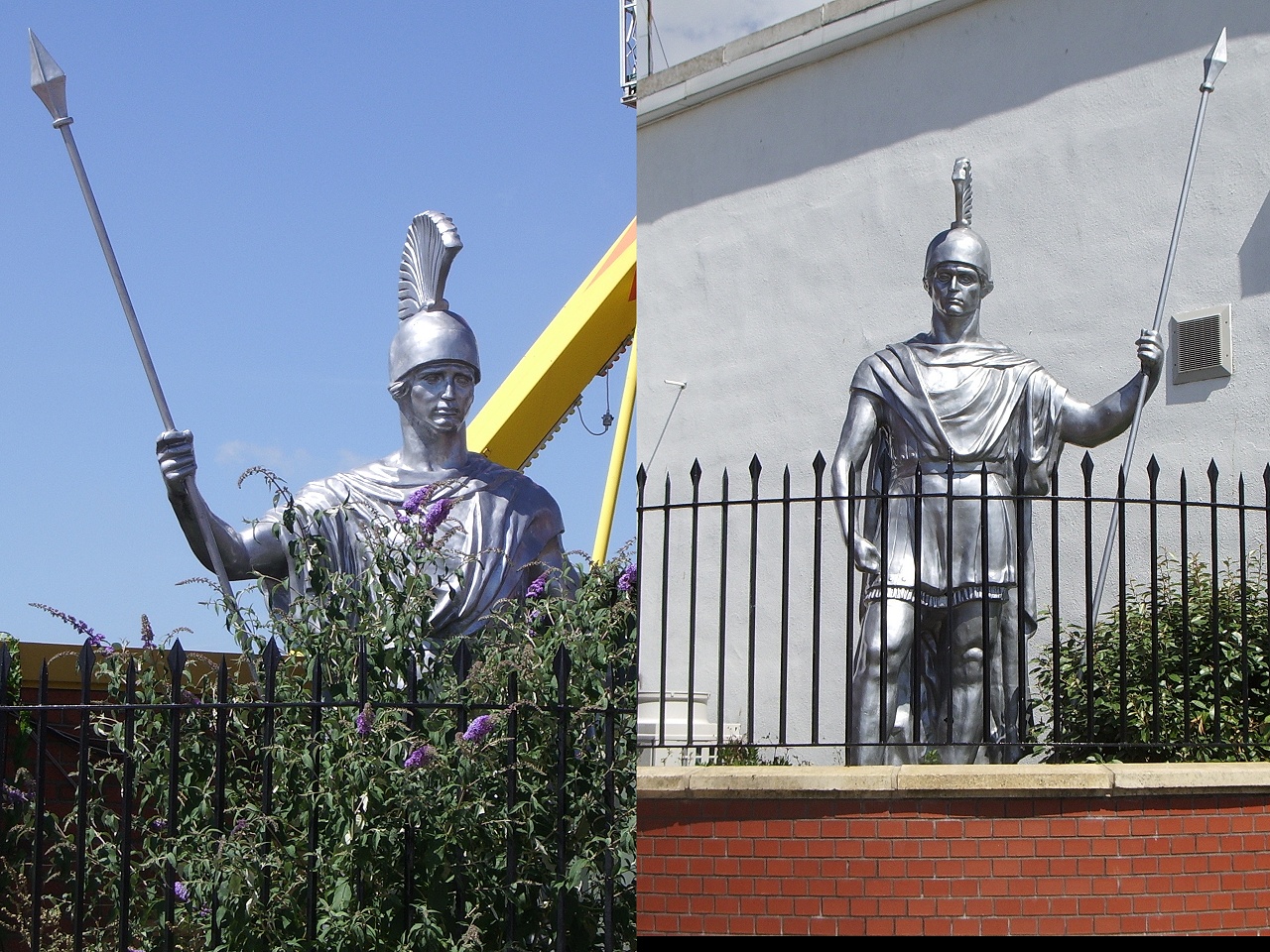
The one on the left is obviously the saddest because he's being overgrown by bushes.
I'd been considering searching the town for the locations where several scenes from the fantastic 2005 Doctor Who episodes "The Empty Child" and "The Doctor Dances" had been filmed (Barry having been deemed a suitable facsimile of a WW2 bombsite), or to see if any traces remained of the huge Butlins camp that used to draw visitors to the resort, but I was in a gloomy frame of mind after the Pleasure Park and so headed back to the beach instead for a cheer-up. On the way past the arcades and chip shops of the centre I was briefly excited by a pub sign promising a free bouncy castle in the beer garden, but decided on reflection that they probably meant a bouncy castle for kids, so I didn't bother going in.
The seafront remained an unspoiled joy, though, and a leisurely wander along the length of the promenade with an ice-cream soon restored your reporter's spirits. As a Scotchman wilting in the fierce English summer heat, I gravitated towards the eastern colonnade, its cool shade untroubled by the swarms of people milling around the shops of the western version, but insanely, the emptiness of the second structure extends as far as not even having any benches in it where a weary traveller can rest their tired limbs, and eventually the only prospect of relief from the searing rays was to get back in my car, drop the roof and drive out of Barry as fast as possible, just to generate a breeze.
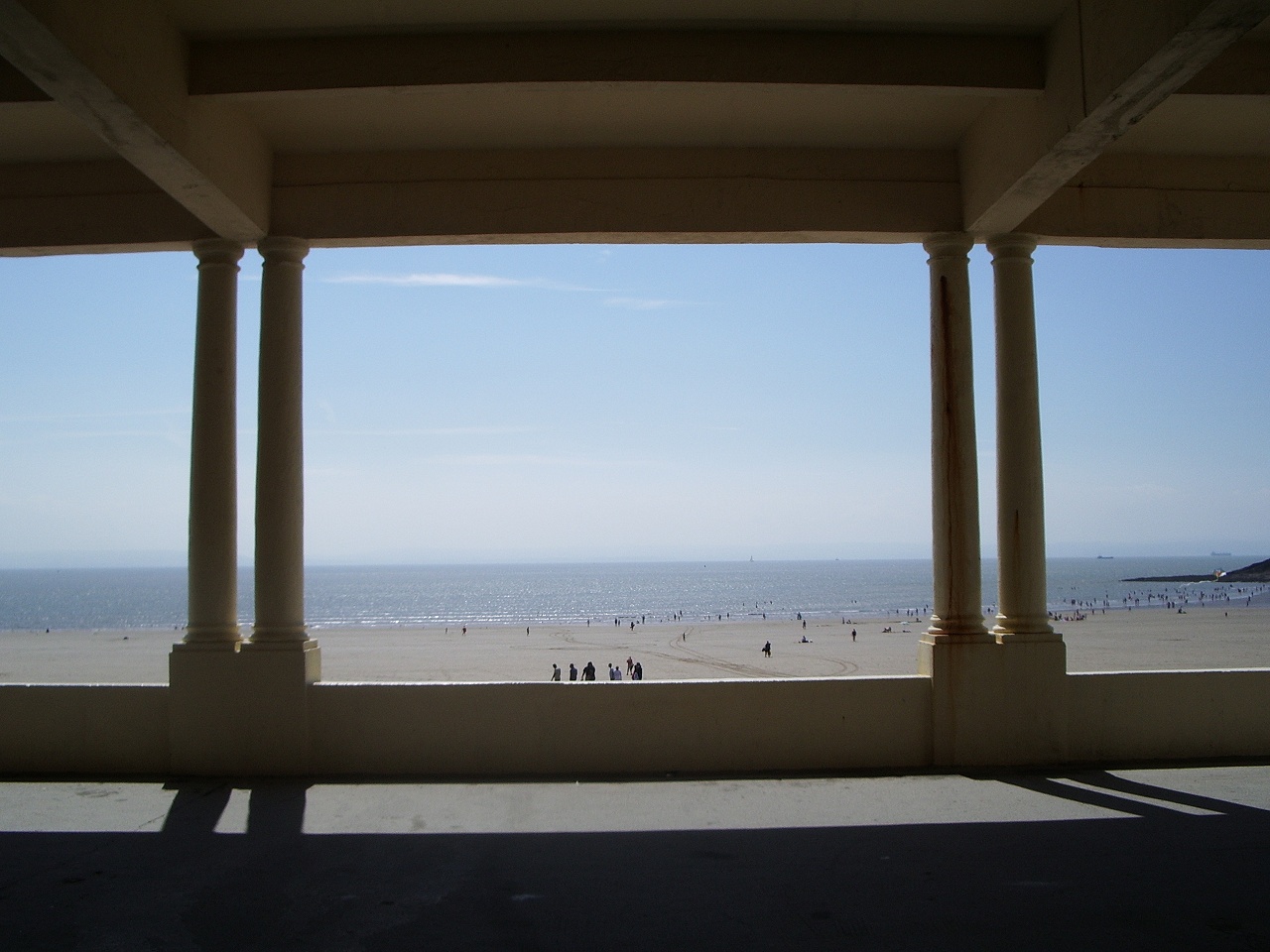
This would be a beautiful place for quiet, peaceful reflection, if you could sit the hell down.
You should go to Barry Island, if you're anywhere within reach of it. Despite - or perhaps because of - being mostly closed, it's an oasis of unlikely beauty and serenity hidden in one of the least promising or inviting locations it's possible to imagine. Just make sure you either get a train, or take junction 33 off the M4 ("Dn7") and not junction 32, because nobody else should ever have to endure a journey through the monstrousness of South Cardiff.
And if you do go there, and you manage to figure out why everything's shut all the time, or why their coin-pushers are full of sawn-off shotguns, or what the mystery structure on the front was and why the roof of it is covered in rusty nails, you will let me know, won't you?

I wonder if the guy in the boat is the original Barry?
|

